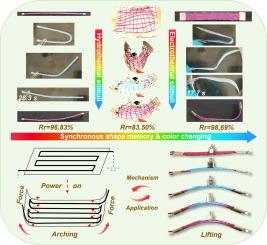Electro-thermal responses polymer systems with continuous shape memory alloys: Merging rapid shape memory and color transitions
IF 13.3
1区 工程技术
Q1 ENGINEERING, CHEMICAL
引用次数: 0
Abstract
Multi-responsive shape memory materials with on-demand programmability via external stimuli are highly desirable for many modern technologies-based applications, but have yet to be mixed with color-changing materials through a 3D-printing approach. To address this challenge, we engineered a blend of polylactic acid (PLA) and polyurethane (TPU), incorporated with thermochromic microcapsules (TMC), and fused these components through melt extrusion to create a 3D-printable, ternary filament. When combined with a shape memory alloy (SMA) wire using continuous fiber-reinforced 3D printing techniques, it gives rise to a PLA/TPU/TMC@SMA composite with exceptional conductivity, intelligent 3D structural adaptability, and superior mechanical characteristics, i.e., 3.29 % elongation at break and a 19.05 MPa tensile strength. Notably, our printed composite strip exhibits outstanding reversibility in electrochromic chromaticity parameters, swiftly recovering to its initial state after electrochromic heating and rapid cooling cycles, thus providing real-time reversible electrochromic responses. Furthermore, our composite strip displays rapid and simultaneous shape and color transformations upon exposure to predefined temperature thresholds, highlighting its dynamic functionality. Incorporating a highly efficient conductive network of continuous SMA wires enables swift electric and thermal shape memory responses, making our PLA/TPU/TMC@SMA composite an ideal candidate for high-performance electro-thermal actuators across diverse applications.

具有连续形状记忆合金的电热响应聚合物系统:融合快速形状记忆和颜色转换
对于许多基于现代技术的应用来说,通过外部刺激具有按需可编程性的多响应形状记忆材料是非常理想的,但尚未通过3d打印方法与变色材料混合。为了应对这一挑战,我们设计了一种聚乳酸(PLA)和聚氨酯(TPU)的混合物,结合了热致变色微胶囊(TMC),并通过熔融挤出将这些成分融合在一起,形成了一种可3d打印的三元长丝。当与形状记忆合金(SMA)丝结合使用连续纤维增强3D打印技术时,它产生了PLA/TPU/TMC@SMA复合材料,具有卓越的导电性,智能3D结构适应性和卓越的机械特性,即3.29 %的断裂伸长率和19.05 MPa的抗拉强度。值得注意的是,我们打印的复合材料条带在电致变色色度参数方面表现出出色的可逆性,在电致变色加热和快速冷却循环后迅速恢复到初始状态,从而提供实时可逆的电致变色响应。此外,我们的复合条在暴露于预定义的温度阈值时显示快速和同步的形状和颜色转换,突出其动态功能。结合连续SMA导线的高效导电网络,可实现快速的电和热形状记忆响应,使我们的PLA/TPU/TMC@SMA复合材料成为各种应用中高性能电热致动器的理想候选者。
本文章由计算机程序翻译,如有差异,请以英文原文为准。
求助全文
约1分钟内获得全文
求助全文
来源期刊

Chemical Engineering Journal
工程技术-工程:化工
CiteScore
21.70
自引率
9.30%
发文量
6781
审稿时长
2.4 months
期刊介绍:
The Chemical Engineering Journal is an international research journal that invites contributions of original and novel fundamental research. It aims to provide an international platform for presenting original fundamental research, interpretative reviews, and discussions on new developments in chemical engineering. The journal welcomes papers that describe novel theory and its practical application, as well as those that demonstrate the transfer of techniques from other disciplines. It also welcomes reports on carefully conducted experimental work that is soundly interpreted. The main focus of the journal is on original and rigorous research results that have broad significance. The Catalysis section within the Chemical Engineering Journal focuses specifically on Experimental and Theoretical studies in the fields of heterogeneous catalysis, molecular catalysis, and biocatalysis. These studies have industrial impact on various sectors such as chemicals, energy, materials, foods, healthcare, and environmental protection.
 求助内容:
求助内容: 应助结果提醒方式:
应助结果提醒方式:


